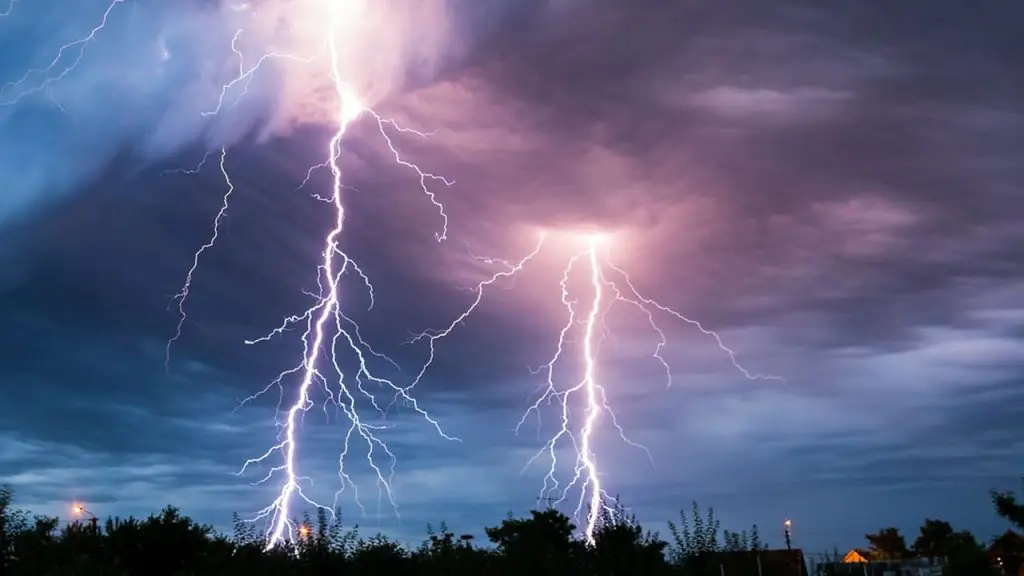There are many different ways lightning can be measured to determine how hot a lightning bolt really is. Lightning can be measured in volts, amperes, joules, kilo-joules, and even degrees Celsius. The hotter the lightning bolt, the more energy it has. This means that lightning with a higher voltage will have a hotter temperature than lightning with a lower voltage.
A Lightning Bolt Is Hotter Than A Flame Because It Has More Energy! Lightning is hotter than fire because of its chemical potential the amount of available energy rather than its thermal potential, which measures the heat in an object as measurable quantities of heat (that is, calories).
Although both are emitted from friction between oxygen and another element (typically nitrogen or phosphorus), lightning’s high-frequency light waves combined with its high voltages give it significantly more energy than the heat given off by fires.

How Hot Is A Lightning Bolt?
The temperature of a lightning bolt depends on a few factors. The biggest variable is distance. Lightning is at its hottest when it’s close enough that it can’t travel as fast. When lightning travels through the air, it heats it up, so the air around it is also warm. As lightning travels, the air gets cooler because the energy is dissipated. Because lightning travels at such a high speed, it only stays hot for a tiny fraction of a second.
The heat lightning generates is produced by chemical reactions taking place inside its charged channel. It’s because lightning strikes so fast that air doesn’t have time to react and become ionized. Instead, the air becomes electrically polarized positively charged on one side and negatively charged on the other. Lightning also creates friction, as it passes through the air that is a lot of different factors contributing to heat lightning is so hot!
How Is Lightning Measured?
Lightning can be measured in volts, amperes, joules, kilo-joules, and even degrees Celsius. The hotter the lightning bolt, the more energy it has. This means that lightning with a higher voltage will have a hotter temperature than lightning with a lower voltage. The most common measurements to determine how hot a lightning bolt really is are the amperes and joules.
The amperes, otherwise known as electrical current, are the main factor for heating up the air and creating the visible light we see when lightning flashes. Joules, on the other hand, are more of an indication of power output and thus, indirect evidence of heat.
Why Is Lightning Hot?
The air around lightning becomes ionized when it instantly reaches a few thousand degrees. A lightning strike gets so hot because it moves so quickly. The charge travels between the cloud and the ground in less than a second. It’s because lightning strikes so fast that air doesn’t have time to react and become ionized.
The electricity travels through the air ionizing it as well. When the electricity travels to the ground, it discharges at 10,000 volts per foot. This is why most people will get hit on their extremities. The electricity travels through the person creating a small spark. The heat comes from this chemical reaction and the ionization of the air.
How Does A Lightning Strike Get So Hot?
The air around lightning becomes ionized when it instantly reaches a few thousand degrees. A lightning strike gets so hot because it moves so quickly. The charge travels between the cloud and the ground in less than a second. It’s because lightning strikes so fast that air doesn’t have time to react and become ionized. Instead, the air becomes electrically polarized—positively charged on one side and negatively charged on the other.
Lightning also creates friction, as it passes through the air—that are a lot of different factors contributing to heat lightning is so hot! The fact that a lightning strike gets so hot comes down to two essential things: friction and electron attraction. As a bolt of lightning travels through the air, there is some resistance due to friction. This generates a lot of heat.
The heat comes from both the air that the lightning is passing through and the electrical charge itself. The electrons in the charge are being pulled toward the ground, and the atoms in the air are being pulled toward the electricity. The air is a poor conductor, so it acts like a break and creates heat.
Is Lightning Hot Enough to Melt Metal?
Yes! Lightning is hot enough to melt metal, which is incredibly impressive. In fact, lightning has been known to cause fires in electrical equipment like transformers, power lines, and railway tracks. A lightning strike can get hot enough to melt metal in as little as 10-25 microseconds! That’s about 1,000 times faster than the blink of an eye.
This is because a lightning bolt is an electric current that travels through the air. When it hits something, like a power line, it can flow through it, which creates a lot of heat. The metals that these power lines and equipment are made out of (like copper and aluminum) are good conductors of electricity, so they get very hot.
Bottom line
As you can see, lightning is indeed very hot. In fact, it’s almost as hot as the surface of the Sun! It’s because lightning travels so quickly that it’s able to generate so much heat. Now that you’ve read all about how hot lightning is, we recommend you keep an eye out for it, just in case!
Now that you’ve read all about how hot lightning is, we recommend you keep an eye out for it, just in case! And if you ever find yourself in the path of a lightning bolt, make sure you know what to do. For more safety tips, keep reading and make sure to keep yourself informed!
Additional Contents:

